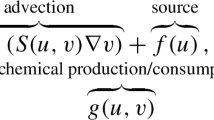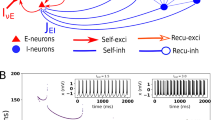Abstract
Cultures of dissociated neurons are an invaluable experimental tool in studying neuronal networks at an intermediate scale in an in vitro controlled physico-chemical environment. Moreover, current micro-fabrication techniques allow the design of a custom connectivity between subpopulations, which could make it possible to carry out computations with devices involving living cells. The quorum percolation (QP) model has been designed in the context of neurobiology to describe bursts of activity occurring in neuronal cultures from the point of view of collective phenomena rather than from a dynamical synchronization approach. Such a model is well suited to describe triggered activity in neuronal devices, and its generic character points at the necessity of heavily structured devices to go beyond collective bursting. We derive a continuous extension of the QP model, seen as information propagation on a non-metric directed graph, and discuss how its critical behavior might give insight on the connectivity of neuronal networks. The link with metric graphs, embedded in a two-dimensional space, is tackled by the introduction of a geometrical model based upon a random walk, where axon growth is constrained by obstacles such as walls and channels. This provides a starting point for the construction of neuronal devices in vitro capable of more complex behaviors. Lastly, we show how simulations of bursts with a dynamical adaptive integrate-and-fire model can be interpreted in terms of QP, confirming the robustness of this synchronized behavior.
Similar content being viewed by others
References
J.P. Eckmann, O. Feinerman, L. Gruendlinger, E. Moses, J. Soriano, T. Tlusty, Phys. Rep. 449, 54 (2007)
M.E. Raichle, Trend. Neurosci. 32, 118 (2009)
P. Guevara, D. Duclap, C. Poupon, L. Marrakchi-Kacem, P. Fillard, D. Le Bihan, M. Leboyer, J. Houenou, J.F. Mangin, NeuroImage 61, 1083 (2012)
I. Breskin, J. Soriano, E. Moses, T. Tlusty, Phys. Rev. Lett. 97, 188102 (2006)
G.W. Gross, B.K. Rhoades, H.M.E. Azzazy, W. Ming-Chi, Biosensors, Bioelectronics 10, 553 (1995)
R. Renault, Emergent design of neuronal devices, Ph.D. thesis, Université Paris-Diderot, Paris, 2015
R. Renault, N. Sukenik, S. Descroix, L. Malaquin, J.-L. Viovy, J.-M. Peyrin, S. Bottani, P. Monceau, E. Moses, M. Vignes, PLoS One 10, 1 (2015)
J.-M. Peyrin, B. Deleglise, L. Saias, M. Vignes, P. Gougis, S. Magnifico, S. Betuing, M. Pietri, J. Caboche, P. Vanhoutte, J.-L. Viovy, B. Brugg, Lab on a Chip 11, 3663 (2011)
S. Stern, M. Segal, E. Moses, EBioMedicine 2, 1048 (2015)
I. Canals, J. Soriano, G. Orlandi et al., Stem Cell Rep. 5, 546 (2015)
T. DeMarse, K. Dockendorf, in Proceedings 2005 International Joint Conference on Neural Networks (IEEE Montreal, Montreal, Que., Canada, 2005), Vol. 3, pp. 1548–1551.
J. Soriano, M. Rodríguez Martínez, T. Tlusty, E. Moses, Proc. Natl. Acad. Sci. U.S.A. 105, 13758 (2008)
Y. Penn, M. Segal, E. Moses, Proc. Natl. Acad. Sci. U.S.A. 12, 3341 (2016)
E.M. Izhikevich, Dynamical systems in neuroscience (MIT Press, Cambridge, Massachusetts, 2007)
A. Arenas, J. Kurths, Y. Moreno, Phys. Rep. 469, 1 (2008)
O. Cohen, A. Keselman, E. Moses, J. Soriano, T. Tlusty, Europhys. Lett. 89, 1 (2010)
L. Hernandez-Navarro, J.G. Orlandi, B. Cerruti, E. Vives, J. Soriano, Phys. Rev. Lett. 118, 208101 (2017)
R. Koene, B. Tijms, P. van Hees, F. Postma, A. de Ridder, G.J. Ramakers, J. Van Pelt, A. Van Ooyen, Neuroinformatics 7, 195 (2009)
B. Torben-Nielsen, E. De Schutter, Front. Neuroanat. 8, 92 (2014)
T. Tlusty, J.-P. Eckmann, J. Phys. A 42, 205004 (2009)
S. Métens, P. Monceau, R. Renault, S. Bottani, Phys. Rev. E 93, 032112 (2016)
D. Stauffer, A. Aharony, Introduction to Percolation Theory (Taylor & Francis, London, 1994)
R. Renault, P. Monceau, S. Bottani, S. Métens, Physica A 414, 352 (2014)
R. Brette, W. Gerstner, J. Neurophysiol. 94, 3637 (2005)
S. Bottani, Phys. Rev. Lett. 74, 4189 (1995)
Author information
Authors and Affiliations
Corresponding author
Rights and permissions
About this article
Cite this article
Monceau, P., Métens, S., Fardet, T. et al. Neuronal devices: understanding neuronal cultures through percolation helps prepare for the next step. Eur. Phys. J. Spec. Top. 227, 1015–1028 (2018). https://doi.org/10.1140/epjst/e2018-800072-1
Received:
Revised:
Published:
Issue Date:
DOI: https://doi.org/10.1140/epjst/e2018-800072-1




